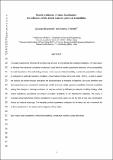| dc.contributor.author | Buscarnera, Giuseppe | |
| dc.contributor.author | Whittle, Andrew | |
| dc.date.accessioned | 2014-09-16T20:41:58Z | |
| dc.date.available | 2014-09-16T20:41:58Z | |
| dc.date.issued | 2013-02 | |
| dc.date.submitted | 2011-07 | |
| dc.identifier.issn | 1090-0241 | |
| dc.identifier.issn | 1943-5606 | |
| dc.identifier.uri | http://hdl.handle.net/1721.1/89666 | |
| dc.description.abstract | This paper examines the influence of the initial state of sands on the potential for undrained instability. The main goal is to illustrate how advanced constitutive modeling of sand behavior can be used to evaluate the susceptibility for static liquefaction. The methodology is based on the concept of latent instability, in which the potential for collapse is contingent on particular boundary conditions. A generalized effective stress soil model, MIT-S1, is used to support the analysis and is combined with a theoretical approach for identifying loss of control owing to undrained shear perturbations. The theory is evaluated using experimental evidence available for Toyoura sand to point out the key role of void ratio and consolidation history and to provide experimental validation for the theory. Model predictions are then used to disclose the subtle role of drained preloading paths in promoting liquefaction instabilities. The ability of the constitutive model to reproduce the interplay between undrained kinematic constraints and material failure is fundamental in predicting potential instabilities arising from changes in drainage conditions. The examples shed light on the mechanics of static liquefaction and set a framework for applying the principles of material stability to the triggering analysis of flow slides induced by undrained shear perturbations. | en_US |
| dc.language.iso | en_US | |
| dc.publisher | American Society of Civil Engineers (ASCE) | en_US |
| dc.relation.isversionof | http://dx.doi.org/10.1061/(asce)gt.1943-5606.0000779 | en_US |
| dc.rights | Creative Commons Attribution-Noncommercial-Share Alike | en_US |
| dc.rights.uri | http://creativecommons.org/licenses/by-nc-sa/4.0/ | en_US |
| dc.source | MIT web domain | en_US |
| dc.title | Model Prediction of Static Liquefaction: Influence of the Initial State on Potential Instabilities | en_US |
| dc.type | Article | en_US |
| dc.identifier.citation | Buscarnera, Giuseppe, and Andrew J. Whittle. “Model Prediction of Static Liquefaction: Influence of the Initial State on Potential Instabilities.” Journal of Geotechnical and Geoenvironmental Engineering 139, no. 3 (March 2013): 420–432. | en_US |
| dc.contributor.department | Massachusetts Institute of Technology. Department of Civil and Environmental Engineering | en_US |
| dc.contributor.mitauthor | Whittle, Andrew | en_US |
| dc.relation.journal | Journal of Geotechnical and Geoenvironmental Engineering | en_US |
| dc.eprint.version | Original manuscript | en_US |
| dc.type.uri | http://purl.org/eprint/type/JournalArticle | en_US |
| eprint.status | http://purl.org/eprint/status/PeerReviewed | en_US |
| dspace.orderedauthors | Buscarnera, Giuseppe; Whittle, Andrew J. | en_US |
| dc.identifier.orcid | https://orcid.org/0000-0001-5358-4140 | |
| mit.license | OPEN_ACCESS_POLICY | en_US |
| mit.metadata.status | Complete | |
